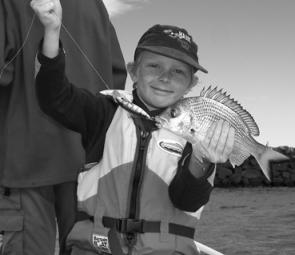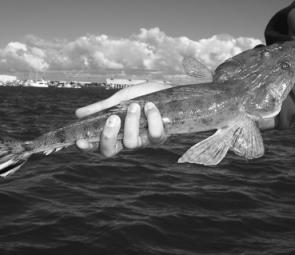While I’m a self-confessed lure and flyfishing nut, there are times when I do a fair bit of baitfishing.
Mainly it’s when conditions aren’t suitable for more active pursuits like lure casting or trolling. Other times, it’s because I’m fishing with less experienced or younger anglers. When my kids were really little for example, we did a lot of baitfishing. Now they are getting older and can do a lot more for themselves, the baitfishing trips have tended to come less frequently.
However, while we might not use bait as our first choice very often these days, it doesn’t mean that we don’t take things seriously when we do. After all the purpose of using bait is to catch fish, so you might as well put the effort in to ensure that you do.
In the estuary, our main baitfishing target is the humble bream. As top class scavengers and opportunistic feeders, bream respond strongly to a well presented bait and are usually attracted to some well placed berley. As luck might have it, our most successful method of targeting bream has been a combination of these two ideas. But rather than use them independently, we actually combine the berley and bait in one package.
Now that might seem a little difficult to achieve, but in reality, it is dead easy. What we do is incorporate a little plastic berley cage into our rig. The ones we use are actually called ‘feeders’ and like most really clever baitfishing ideas, they are taken straight out of English coarse fishing techniques.
Feeders are actually little plastic containers, which you fill with berley and attach to your line. Feeders can be either open-ended (with a removable cap on each end) or blocked (like a film canister with a cap on only one end) but they all have several rows of holes in the sides to allow the berley to flow out. Feeders are usually heavily weighted so they sink to the bottom and most come fitted with a snap swivel so they can be easily attached on your line. I normally put the feeder at the top of my rig, on the main line above the swivel. Below the swivel I fit a fairly short trace of slightly lighter line to a small chemically sharpened hook.
The use of chemically sharpened hooks is vital to this technique, as you don’t strike to set the hook. What happens is that the fish picks up the bait and tries to swim off, but it can’t go far before the trace is pulled tight and the hook is driven home by the resistance of the feeder. All you do is wait until you see the rod tip load up and then you pick the rod up out of the holder and wind the fish in.
Because the fish hooks itself, it’s important that the line between the feeder and hook is lighter than the main line. That way, if the fish busts you off, your line should break at the trace and the fish won’t be left to drag a heavy feeder around with it for the rest of its days.
It sounds simple and it is. It is also a deadly baitfishing technique that anyone can use to improve their fishing results. And don’t be fooled into thinking that it will only work on bream – anything from flathead and whiting to tailor or trevally will get involved, so you have to expect the unexpected.
While the information above is the basis of the system, there are a few other bits and pieces of information worth noting.
The first is the choice of rod. Even though the feeder is pretty heavy, you still need to use a slow action rod with a nice soft tip. There are a couple of very important reasons why. Firstly, as the rod is usually left sitting in the holder and you need to be able to see when a fish is interested in the bait. Also, because there is a heavy weight on the line, the gentle action of the rod helps to cushion any sudden lunges by the fish.
I use a Jarvis Walker nibble tip rod for this sort of fishing. It isn’t an expensive version but it does the job nicely and is streets ahead of most other rod designs for this sort of work as you can see the slightest movement of the flexible nibble tip.
You don’t need heavy line for this caper either and my favourite reel is a little Shimano Baitrunner spooled with fine diameter 4kg Platypus. Mine is actually one of the original 1500 Baitrunners that have come to be a bit of a collector’s item these days. The trace material is 3kg line, also from Platypus.
The choice of bait is a bit of a contentious issue and the fish can change their moods from one day to the next. However I’m prepared to stick my neck out and say that artificial baits like Stimulate are really worth using with this technique, particularly if you have young kids on board.
These dough-based baits are easy for kids to put on and tend to stay on the hook better than other store bought baits like frozen prawns. As they last for ages in their unmixed state, you can keep a packet on hand for whenever you need it. On top of that, bream love the stuff.
My other reason for using Stimulate is that it goes really well with the pre-packaged berley products from the same company. With these pre-made berley products, you get an easy to use and effective berley straight from the pack and there is no messy mixing of ingredients. Whether the fish feeding stimulant Ultrabite, which is added to these products, is the reason they work so well is still up for discussion, but I can assure you that they work.
To bait up, all you do is pinch a small bit of Stimulate on the hook, then fill the berley cage with a scoop of ground berley and then put the lid back on. Once you are set, you simply cast your bait out, sit the rod in the holder and wait. Odds are you won’t have to wait long as this combination has proven to be a very deadly in Central Queensland.
Baitfishing may not be the most glamorous method of catching bream but it would have to be one of the most productive options available. If you use these techniques, you will catch plenty of fish, and quite possibly a few more than you need, so make sure you practice responsible fishing practices and release plenty for next time.
Reads: 14285
Bream are a lot of fun to catch on lures but a well presented bait will rarely be overlooked.

Flathead like this little bartail are a welcome by-catch when baitfishing for bream.

A flexible nibble tip rod will show even the slightest bite.

A nibble tip, feeder (berley cage) and chemically sharpened hook are the key ingredients in this fishing recipe. The black plastic tube the feeder is attached to is called a ‘boom’ and it helps prevent the rig from tangling during the cast.

The two common types of feeders. The green ones are blocked, while the brown ones are open ended (the caps can be removed off each end if needed).

Big blue nosed bream like this one are suckers for feeder fishing techniques.

Fishing for bream with berley cages is so easy even kids can do it.

Pre-prepared baits and berley like the Stimulate range are ideal for use with berley cage techniques.




